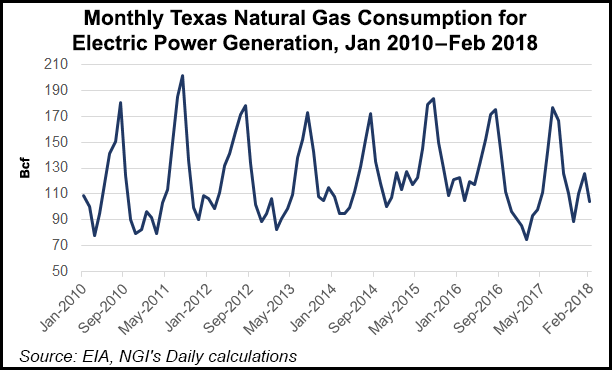Infrastructure | NGI All News Access
Texas Electric Grid Operator Able to Meet Expected Record Demand This Summer
The Electric Reliability Council of Texas (ERCOT) continues to expect record peak usage this summer, but the grid operator for most of the state said Monday that it has sufficient resources to meet the strong demand.

ERCOT’s final seasonal assessment of resource adequacy (SARA) for June through September, issued Monday, includes a 72,756 MW summer peak load forecast based on normal weather conditions. The forecast is more than 1,600 MW higher than the all-time peak demand record set in August 2016.
“This anticipated record demand, combined with recent plant retirements and delays in some planned resources, is expected to result in tight reserves that could trigger the need for ERCOT to deploy such resources as Ancillary Services and contracted Emergency Response Service capacity to maintain sufficient operating reserve levels,” the final SARA states.
ERCOT may also request that transmission and/or distribution service providers implement load control measures with their customers. Based on the grid operator’s December 2017 Capacity, Demand and Reserves (CDR) report, there is approximately 2,300 MW of such additional capacity available for addressing reserve deficiency situations.
ERCOT also anticipates further voluntary load reductions and an increase in power sold in the market by industrial facilities in response to higher power prices during peak demand.
Since the preliminary SARA for the summer was released in March, total generation resource capacity has increased by more than 500 MW to 78,184 MW due to units returning from mothball status and extended outage status, as well as a planned gas-fired resource becoming available earlier than initially expected, ERCOT said.
The change in total capacity also reflects some minor decreases such as a smaller private use network capacity contribution and the postponement of the projected in-service date for a small planned gas-fired unit to the fall of 2018. The total amount of planned additions for the summer now stands at 728 MW, constituting 345 MW of thermal sources and 383 MW of renewables based on the expected summer peak capacity contributions.
The final summer unit outage forecast of 4,349 MW remains unchanged from the preliminary summer SARA report. ERCOT developed this forecast from outage data from the last three summer seasons.
“ERCOT and the market participants we work with are focused on system performance this summer,” ERCOT President and CEO Bill Magness said. “A growing economy and retirements of generating units will tighten reserves available on peak summer days.”
The planning reserve margin for summer 2018 has increased to 11% based on the resource updates incorporated in the final summer SARA report. The May CDR, which was also released Monday and summarizes the summer periods from 2019-2023, shows reserves through 2022 in the range of 10.9% to 12.3%.
The CDR and SARA reports reflect the anticipated resource capacity available to meet the forecast summer peak demand. This anticipated capacity may differ from what will actually be available based on system conditions and the operational status of the resources, ERCOT said.
Since the December 2017 CDR report, the 2019 summer demand forecast was lowered to 74,202 MW due to a delay in a new industrial facility located on the Texas coast. The peak demand forecast also has been adjusted upward starting in 2021 to reflect the planned integration of Lubbock Power & Light customers.
ERCOT manages the flow of electric power to 24 million Texas customers, representing about 90% of the state’s electric load. The ERCOT wholesale market provides financial incentives for generators to be available when demand rises, and for retail electric providers to prepare for price fluctuations.
In a statement made in March regarding the preliminary SARA, the Public Utility Commission of Texas (PUC) said it “continues to closely monitor the forecast for electricity supply and demand for this coming summer.
“As expected, the decisions of generation owners to retire several large coal-fired power plants has significantly reduced the excess supply of electricity that the ERCOT power region has enjoyed over the past five years,” the PUC said.
Although this summer is expected to be tighter than in recent years, PUC said ERCOT is designed with several mechanisms and tools to incentivize increases in supply or temporary reductions in demand to maintain the reliability of the system.
“These tools include programs operated by ERCOT, retail electric providers and distribution utilities that compensate customers who can temporarily reduce their demand or operate their own generation if outages of large power plants occur during extreme weather conditions,” PUC noted.
© 2024 Natural Gas Intelligence. All rights reserved.
ISSN © 1532-1231 | ISSN © 2577-9877 |
